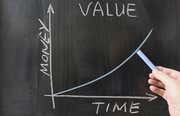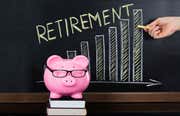
|
Compounding is the process of generating more return on an asset's reinvested earnings. To work, it requires two things: the reinvestment of earnings and time. Compound interest can help your initial investment grow exponentially. For younger investors, it is the greatest investing tool possible, and the #1 argument for starting as early as possible. Below we give a couple of examples of compound interest.
Example #1: Apple stock
An investment of $10,000 in the stock of Apple (AAPL) that was made on December 31, 1980 would have grown to $2,709,248 as of the market’s close on February 28, 2017 according to Morningstar’s Advisor Workstation tool. This translates to an annual return of 16.75%, including the reinvestment of all dividends from the stock.
Apple started paying dividends in 2012. Even so, if those dividends hadn’t been reinvested the ending balance of this investment would have been $2,247,949 or 83% of the amount that you would have had by reinvesting.
While Apple is one of the most successful companies, and their stock is a winner year-in and year-out, compound interest also works for index funds, which are managed to replicate the performance of a major market index such as the S&P 500.
Example #2: Vanguard 500 Index
Another example of the benefits of compounding is the popular Vanguard 500 Index fund (VFINX) held for the 20 years ending February 28, 2017.
A $10,000 investment into the fund made on February 28, 1997 would have grown to a value of $42,650 at the end of the 20-year period. This assumes the reinvestment of all fund distributions for dividends, interest or capital gains back into the fund.
Without reinvesting the distributions, the value of the initial $10,000 investment would have grown to $29,548 or 69% of the amount with reinvestment.
In this and the Apple example, current year taxes would have been due on any fund distributions or stock dividends if the investment was held in a taxable account, but for most investors, these earnings can grow tax-deferred in a retirement account such as a employer-sponsored 401(k).
Starting Early
Another way to look at the power of compounding is to compare how much less initial investment you need if you start early to reach the same goal.
A 25-year-old who wishes to accumulate $1 million by age 60 would need to invest $880.21 each month assuming a constant return of 5%.
A 35-year-old wishing to accumulate $1 million by age 60 would need to invest $1,679.23 each month using the same assumptions.
A 45-year-old would need to invest $3,741.27 each month to accumulate the same $1 million by age 60. That’s almost 4 times the amount that the 25-year old needs. Starting early is especially helpful when saving for retirement, when putting aside a little bit early in your career can reap great benefits.
Investing 101: Knowing Yourself
-
 Investing
InvestingContinuous compound interest
Different frequency in compound interest results in different returns. Check out how continuous compounding accelerates your return. -
 Investing
InvestingHow Dividend Reinvestment Grows Your Money Faster
Dividend reinvestment is a smart strategy for growing your investments faster over the long term, but it’s not a get-rich-quick proposition. -
 Investing
InvestingOvercoming Compounding's Dark Side
Understanding how money is made and lost over time can help you improve your returns. -
 Investing
Investing5 Ways to Lose Money With a Dividend Reinvestment Plan
Enrolling in a dividend reinvestment plan can backfire if you're not using it wisely, costing you money in the process. -
 Retirement
RetirementCompounding Is Important in the Later Years Too
The power of compounding is even greater in the later years of saving for retirement. -
 Personal Finance
Personal FinanceHow Interest Rates Work on Savings Accounts
Here's what you need to know to grow your rainy-day fund so you needn't fear a little downturn. -
 Investing
Investing5 Best Ways to Earn Interest
Learn how to use tools to increase your interest earnings. Use compounding interest and breakpoints to increase your interest income. -
 Retirement
RetirementWhat Your 401(k) Can Look Like in the Next 20 Years
Discover how time and compounded growth of earnings can help even a modest 401(k) balance grow to a significant sum over 20 years. -
 Investing
InvestingHow to Make the Time Value of Money Work for You
How to make the time value of money and power of compounding work for you. Here's a hint: Start saving now.


